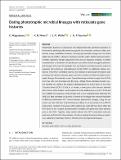Dating phototrophic microbial lineages with reticulate gene histories
Author(s)
Magnabosco, C.; Moore, Kelsey Reed; Wolfe, Joanna Michelle; Fournier, Gregory P.
DownloadMagnabosco_et_al-2018-Geobiology.pdf (909.0Kb)
PUBLISHER_CC
Publisher with Creative Commons License
Creative Commons Attribution
Terms of use
Metadata
Show full item recordAbstract
Phototrophic bacteria are among the most biogeochemically significant organisms on Earth and are physiologically related through the use of reaction centers to collect photons for energy metabolism. However, the major phototrophic lineages are not closely related to one another in bacterial phylogeny, and the origins of their respective photosynthetic machinery remain obscured by time and low sequence similarity. To better understand the co-evolution of Cyanobacteria and other ancient anoxygenic phototrophic lineages with respect to geologic time, we designed and implemented a variety of molecular clocks that use horizontal gene transfer (HGT) as additional, relative constraints. These HGT constraints improve the precision of phototroph divergence date estimates and indicate that stem green non-sulfur bacteria are likely the oldest phototrophic lineage. Concurrently, crown Cyanobacteria age estimates ranged from 2.2 Ga to 2.7 Ga, with stem Cyanobacteria diverging ~2.8 Ga. These estimates provide a several hundred Ma window for oxygenic photosynthesis to evolve prior to the Great Oxidation Event (GOE) ~2.3 Ga. In all models, crown green sulfur bacteria diversify after the loss of the banded iron formations from the sedimentary record (~1.8 Ga) and may indicate the expansion of the lineage into a new ecological niche following the GOE. Our date estimates also provide a timeline to investigate the temporal feasibility of different photosystem HGT events between phototrophic lineages. Using this approach, we infer that stem Cyanobacteria are unlikely to be the recipient of an HGT of photosystem I proteins from green sulfur bacteria but could still have been either the HGT donor or the recipient of photosystem II proteins with green non-sulfur bacteria, prior to the GOE. Together, these results indicate that HGT-constrained molecular clocks are useful tools for the evaluation of various geological and evolutionary hypotheses, using the evolutionary histories of both genes and organismal lineages.
Date issued
2018-03Department
Massachusetts Institute of Technology. Department of Earth, Atmospheric, and Planetary SciencesJournal
Geobiology
Publisher
Wiley
Citation
Magnabosco, C., et al. “Dating Phototrophic Microbial Lineages with Reticulate Gene Histories.” Geobiology, vol. 16, no. 2, Mar. 2018, pp. 179–89. © 2018 The Authors.
Version: Final published version
ISSN
1472-4677